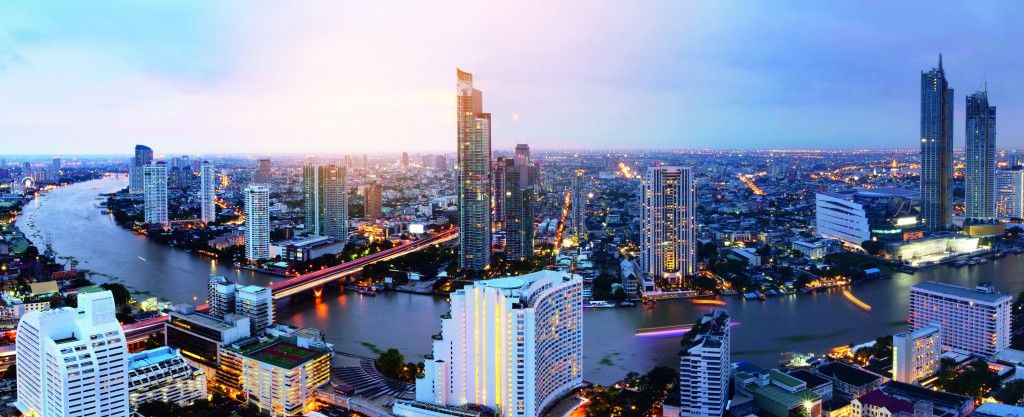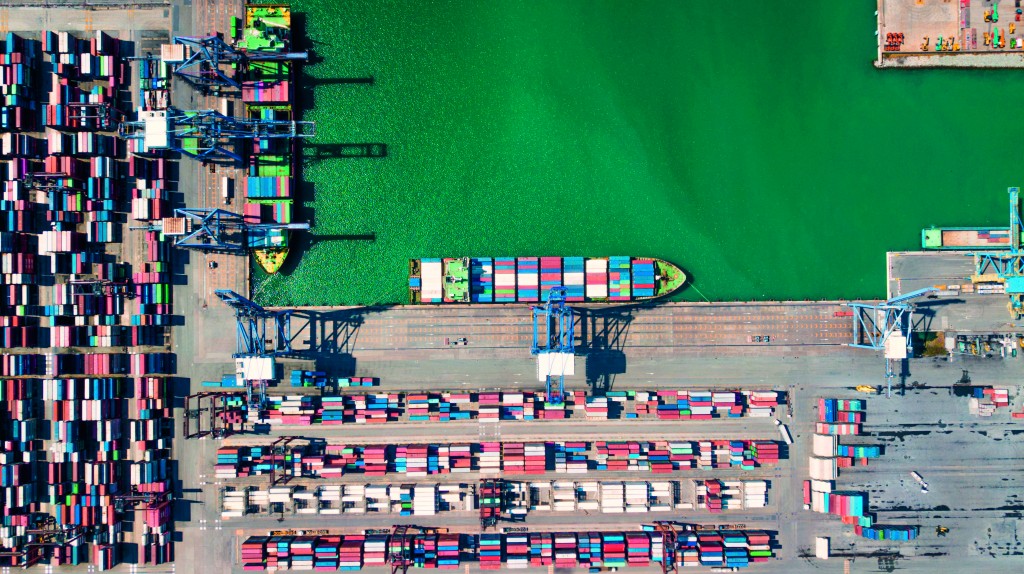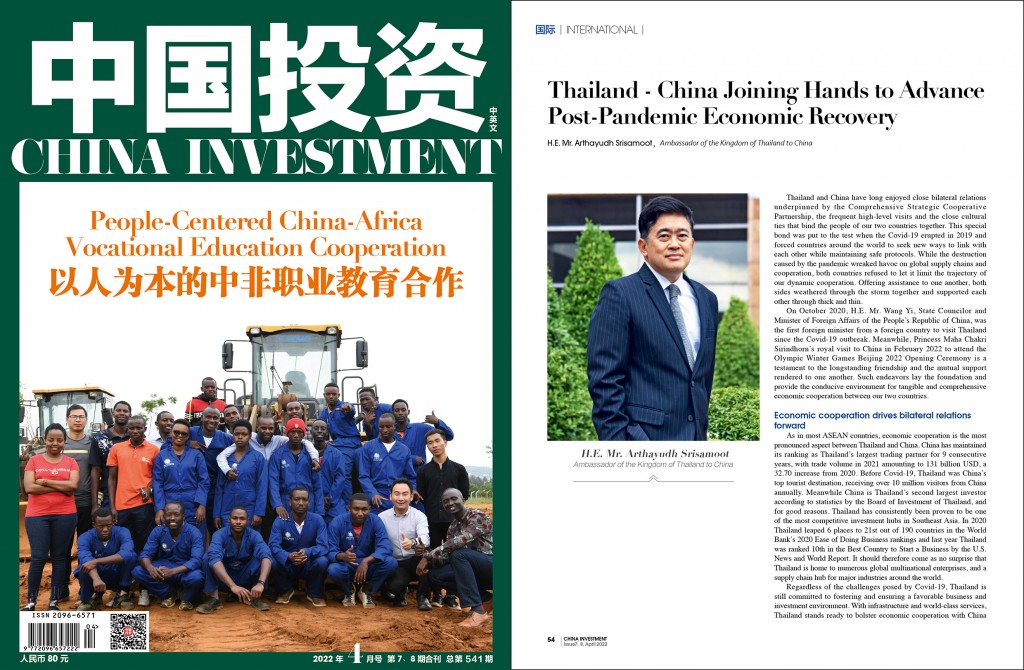H.E. Mr. Arthayudh Srisamoot,Ambassador of the Kingdom of Thailand to China
文|阿塔育·习萨目(Arthayudh Srisamoot) 泰国驻华大使 翻译|王晓波
导读
●经济合作推动双边关系向前发展
●通过生物-循环-绿色模型实现可持续恢复
●展望未来
Thailand and China have long enjoyed close bilateral relations underpinned by the Comprehensive Strategic Cooperative Partnership, the frequent high-level visits and the close cultural ties that bind the people of our two countries together. This special bond was put to the test when the Covid-19 erupted in 2019 and forced countries around the world to seek new ways to link with each other while maintaining safe protocols. While the destruction caused by the pandemic wreaked havoc on global supply chains and cooperation, both countries refused to let it limit the trajectory of our dynamic cooperation. Offering assistance to one another, both sides weathered through the storm together and supported each other through thick and thin.
On October 2020, H.E. Mr. Wang Yi, State Councilor and Minister of Foreign Affairs of the People’s Republic of China, was the first foreign minister from a foreign country to visit Thailand since the Covid-19 outbreak. Meanwhile, Princess Maha Chakri Sirindhorn’s royal visit to China in February 2022 to attend the Olympic Winter Games Beijing 2022 Opening Ceremony is a testament to the longstanding friendship and the mutual support rendered to one another. Such endeavors lay the foundation and provide the conducive environment for tangible and comprehensive economic cooperation between our two countries.

⬆ Bangkok’s skyline and river view
Economic cooperation drives bilateral relations forward
As in most ASEAN countries, economic cooperation is the most pronounced aspect between Thailand and China. China has maintained its ranking as Thailand’s largest trading partner for 9 consecutive years, with trade volume in 2021 amounting to 131 billion USD, a 32.70 increase from 2020. Before Covid-19, Thailand was China’s top tourist destination, receiving over 10 million visitors from China annually. Meanwhile China is Thailand’s second largest investor according to statistics by the Board of Investment of Thailand, and for good reasons. Thailand has consistently been proven to be one of the most competitive investment hubs in Southeast Asia. In 2020 Thailand leaped 6 places to 21st out of 190 countries in the World Bank’s 2020 Ease of Doing Business rankings and last year Thailand was ranked 10th in the Best Country to Start a Business by the U.S. News and World Report. It should therefore come as no surprise that Thailand is home to numerous global multinational enterprises, and a supply chain hub for major industries around the world.
Regardless of the challenges posed by Covid-19, Thailand is still committed to fostering and ensuring a favorable business and investment environment. With infrastructure and world-class services, Thailand stands ready to bolster economic cooperation with China and welcome more Chinese and foreign businesses and investment to our country. To that end, the Thai government has rolled out numerous initiatives and policies to transform Thailand into the globally recognized investment hub and contribute to the advancement of post-pandemic economic recovery in the region and beyond.
1. A Hub for Digital Innovation
Launched in 2016, “Thailand 4.0,” is the country’s long-term strategy to propel the country forward based on an economic model that focuses on creativity, innovation, new technology and high-level services, and aims to transition Thailand into a value-based economy. At the heart of this ambitious plan is the Eastern Economic Corridor (EEC), an area-based development initiative, where for 30 years, numerous business developers have experienced rewarding investment journey and exceptional achievements. Spanning over 13,000 sq.km. across the three provinces of Chonburi, Rayong, and Chachoengsao, EEC has designated areas including the Eastern Economic Corridor of Innovation (EECi), Digital Park Thailand (EECd), and numerous industrial zones.
Thailand possesses a strong level of digital readiness with a high penetration rate for internet usage, social media engagement, mobile connections, online shopping and digital payments. Thailand is currently the front-runner in 5G development in the whole of ASEAN, and EEC is proof of that. Its digital infrastructure is well equipped with the fastest and widest coverage of 5G to support the industries of the future such as automation, artificial intelligence, and robotics, just to name a few.
With its various investment incentive packages, low cost of living, smart visa schemes, advanced STI facilities, and regulatory sandbox mechanisms, the EEC can enable our prospective Chinese investors to pursue innovative business models in new technologies without the prohibitive regulatory constraints.
2. A Hub for Regional Trade and Commerce
As ASEAN’s second largest economy, investors seeking to establish production base in Thailand can tap into the market of around 70 million people, and can benefit from the country’s open economy, abundant skilled workforce, rich natural resources, and a springboard to access other prospective markets in the region. To date, Thailand has signed a total of 14 Free Trade Agreements (FTAs) covering 18 countries, with the Regional Comprehensive Economic Partnership (RCEP) being the latest one. As the world’s largest FTA accounting for 30% of the global GDP, the timely entry into force of the agreement reflects the region’s commitment to keeping the markets open for trade and investment and enhancing regional economic integration. RCEP would deliver new opportunities for businesses, including MSMEs, enhance supply chain resilience in the region, accelerate regional economic integration and contribute to global post-pandemic recovery efforts.
Our businesses in exporting, manufacturing sectors and e-commerce, as well as SMEs are among key sectors that can leverage on the RCEP. Local companies in manufacturing sectors, such as auto-parts and food processing, can strengthen the integration in the regional value and supply chain with supply of raw materials, components, semi-finished and finished goods in the RCEP market. With industrial integration, SMEs will have greater opportunities to be engaged in global and regional value chain.
Thailand stands ready to working closely with China, along with other RCEP members, for the effective implementation of the RCEP to ensure an open, transparent, equitable trade and investment environment, as well as to support our businesses to move towards more resilient and sustainable growth. With a view to promoting cross-border e-commerce through the implementation of RCEP, Thailand looks forward to China’s support for e-commerce and MSMEs development, in particular through enabling MSMEs to engage in e-commerce sector, enhancing digital skills, innovation and technology for MSMEs as they are key contributors to economic growth and employment in the region, as well as enhancing digitalization of trade along the supply chains.
Furthermore, in order to boost bilateral trade with China at the provincial level, in 2021 Thailand signed a mini free trade agreement with Hainan province, China’s new free trade port. Future mini-FTAs as well as sister cities cooperation can provide an enabling environment for business and trade cooperation between the people of our two countries.
3. A Hub for Transportation and Connectivity
Strategically situated at the heart of ASEAN, Thailand is well-connected to the fast-growing Cambodia, Laos, Myanmar, Vietnam (CLMV) sub-region by seamless transportation infrastructure, including rail, road, water and airways and is conveniently South East Asia’s gateway to other regions of the world.
As a regional aviation hub, Thailand boasts 6 international airports and with a coastline of 3,148 km Thailand operates some of the busiest ports in the region. The high-speed rail linking 3 airports, the U-tapao international airport and Airport city, and the Phase 3 of Laem Chabang Port and Map Ta Phut Industrial Port are some of megaprojects in the EEC area currently under development with the support from the public and private partnership.
Connectivity with China has been Thailand’s focus through the integration of the Belt and Road Initiative and China’s pan-Asia infrastructure goals. The R8, R9 and R12 roads offer important trading routes linking Thailand and China, meanwhile both countries are expediting the flagship Thailand – China High-speed Railway Project to connect with the completed China – Laos Railway project. These inter-linkages of multimodal transportation are in accordance with the principles of China’s New International Land-Sea Trade Corridor. Furthermore, in recent years, Thailand have further strengthened intra-linkages with China by enhancing strategic synergies between EEC, Guangdong-Hong Kong-Macao Greater Bay Area (GBA) and Yangtze River Delta (YRD).
As part of our transition to a low-carbon society, Thailand aspires to be the leading regional production hub for EVs and EV batteries. The National EV Policy Committee has set targets of manufacturing zero-emissions vehicles (ZEVs) of at least 30% of total car production by 2030, in tandem with the plan to introduce EV investment incentives, restructure excise tax, build conducive regulatory ecosystem, and install more charging stations. Comparable to China’s “Dual Carbon Goal”, such measures demonstrate Thailand’s commitment to combatting climate change and the ultimate goal of reaching carbon neutrality in 2050 and net zero emissions by 2065.
4. A Hub for Medical and Wellness
The relatively low cost of treatment, high standard care and hospitality, and tranquil environments to rest and recover has earned Thailand the place as Asia’s leading medical tourism destination. In recent years, Thai health professionals have sought to integrate Thai traditional medicine with Western medicine and traditional Chinese medicine. In addition, we have expanded numerous projects with China to integrate technology into the country’s medical industry. As early as June 2020, Siriraj Hospital and Huawei had developed 5G technology applications to launch self-driving vehicles for “contactless” delivery of medical supplies to Covid-19 cases in the hospital. On 19 December 2021, Thai Prime Minister Prayut presided over an inauguration event for the “Siriraj World Class 5G Smart Hospital” which also marked the launch of a Joint Innovation Lab between Bangkok’s Siriraj Hospital and Huawei to incubate innovative 5G medical applications. Since then, new projects such as 5G portable medical boxes, 5G medical carts and 5G smart hospital beds have been piloted and in 2022 over 30 5G medical applications is expected to be incubated and promoted nationwide.
As of February 2022, Thailand has administered two doses of vaccines to approximately 71% of its population. Looking forward the Thai government has adopted a policy for “Smart Control and Living with Covid-19” so that normalcy can return as much and as soon as possible. The country is being gradually opened up for international travel, but with necessary health precautions in place. Thailand seeks to work with China to reconnect the region in all dimensions through the promotion of safe and seamless resumption of cross-border travel by establishing travel protocol, enhance interoperability and mutual recognition of vaccine certificates.
5. A Hub for International Cooperation
Thailand has always taken a proactive role as a bridge builder in connecting Thailand to the World and connecting the World to Thailand. We have constructively engaged with China and our partners through meaningful dialogues and have had the privilege to host numerous high-level international summits in the last few years, from the 8th Ayeyawady-Chao Phraya-Mekong Economic Cooperation Summit (ACMECS) in 2018 to the 35th ASEAN Summit in 2019.
Last year Bangkok’s global ranking as a convention city has moved up from 8th place in 2020 to 6th according to the International Congress and Convention Association (ICCA). This significant title could not be more timely as the city gears up for the resumption of meetings, incentives, conferences, and exhibitions (MICE).
In 2022, Thailand is proud to assume the chairmanship of the Asia-Pacific Economic Cooperation (APEC) under the theme “Open. Connect. Balance.”, as we will open to all opportunities, connect in all dimensions and be balanced in all aspects. “Chalom”, a Thai bamboo basket used in ancient times to carry travel goods was ingeniously chosen as the logo for Thailand’s host year. The interlaced bamboo strips’ strong, resilient, and durable characteristics reflect the qualities necessary to bolster the regional economy meanwhile the 21 openings in between the interwoven bamboo strips signify the 21 member economies in APEC which must work in unison to promote “stability, prosperity and sustainability” in the region.
Thailand’s goal as APEC chair is to be a constructive player. As members have also been negotiating for an APEC Free Trade Area for several years, Thailand will work in support of achieving that ambition of realizing a Free Trade Area of the Asia-Pacific (FTAAP). This is in line with our priorities to facilitate trade and investment, reconnect the region and promote inclusive and sustainable growth.
Sustainable Recovery through BCG Model
As we all continue to face challenges in our recovery from the impact of Covid-19, the Thai government has adopted the Bio-Circular-Green Model (BCG Model) as our post-Covid national strategy for sustainable recovery, with the objective of “building back better” and greener towards a more sustainable and inclusive future.
The BCG Model is a combination of concepts already familiar to most countries, with adjustments to address local and current contexts in Thailand. It applies a whole-of-society approach and integrates bioeconomy, circular economy, and green economy with advanced technologies and innovations throughout the supply chains to boost competitiveness, enhance resource efficiency, transform waste into wealth, regenerate biodiversity, and mitigate impacts on the environment.
Although the BCG Model is our national agenda, we believe the concept can also be applied and developed in a much broader scope. As the ASEAN Coordinator on Sustainable Development Cooperation and also APEC Host and The Bay of Bengal Initiative for Multi-Sectoral Technical and Economic Cooperation (BIMSTEC) Chair in 2022, Thailand hopes to drive BCG cooperation in the region and beyond to rebuild our economies in the post-pandemic world and advance a more balanced and sustainable growth that leaves no one behind.
Looking Forward
Economic recovery is indeed a slow and gradual process. If anything, Covid-19 has reminded us that no country can tackle this issue alone and international cooperation and the exchanges of best practices are crucial to amplify individual countries’ efforts. While the global economy has shown remarkable resilience throughout the pandemic, but history shows that real recoveries depend on adaptability and internationally coordinated strategies to facilitate the rebuilding of socioeconomic systems in an inclusive and sustainable manner. The key to any recovery effort is the alignment of the strategies from all stakeholders to help prepare for future risks and pandemics. Getting there will depend on effectively and holistically addressing the conditions of our economies and navigating through it with coordinated measures. In this respect, China, as the region’s largest economy and a frontrunner in its battle against Covid-19, will have a crucial role to play.
Thailand welcomes deeper and more comprehensive economic cooperation with China to utilize the advantages and benefits of Thailand, as well as to help advance Thailand’s status as an important regional hub. Thailand’s Investment promotion regime has long been among the most successful in Asia due to a host of consistent government policies that all support the private sector as the engine of economic growth. Established in 2009 and located at the center of Bangkok, the One Start One Stop Investment Center or OSOS brings together staff from over 38 investment-related agencies to offer investors greater convenience in providing information and consultations related to doing business in Thailand.
Looking forward, the year of the Tiger will bring new opportunities and with it unprecedented trail and turbulences, but I am optimistic that the close cooperation between Thailand and China will allow us to navigate through these challenges with new found hope. As President Xi Jinping has eloquently phrased in his speech to the 2022 World Economic Forum virtual session on 17 January 2022, “To meet the severe challenges facing humanity, we must ‘add wings to the tiger’ and act with the courage and strength of the tiger to overcome all obstacles on our way forward.” In conclusion, I am confident that Thailand and China will join hands to bring economic cooperation to new heights and contribute proactively to the post-pandemic economic recovery of this region and beyond.
基长期以来,泰国和中国一直保持着密切的双边关系,这一关系的基础是双方签署的全面战略合作伙伴关系、两国高层领导人经常性的互访以及两国人民之间牢固的文化联结。这一非同寻常的关系在2019年新冠疫情爆发后也经受住了考验,因为疫情迫使世界各国在保护自身安全的同时都在寻求建立新的联结方式。虽然疫情造成的破坏严重损害了全球的供应链与合作,但泰中两国都没有让其阻碍我们之间充满活力的合作态势。双方互相帮助,共同经历风雨,而且无论遇到怎样的困难都会彼此支持。
2020年10月,中华人民共和国国务委员兼外交部长王毅先生成为自新冠疫情爆发以来首位访问泰国的外交部长。2022年2月泰国公主玛哈·扎克里·诗琳通访问中国并参加了北京冬奥会的开幕式,这是两国友谊源远流长和相互支持的见证。这些努力为两国全面务实的经济合作进一步奠定了基础,也创造了有利环境。

⬆ 泰国林查班港是泰国最重要的国际集装箱枢纽港之一,也是东南亚地区重要的现代化深水港(新华社记者 王腾摄)
经济合作推动双边关系向前发展
与大多数东盟国家一样,经济合作是泰中两国之间最突出的方面。中国连续9年保持着泰国最大贸易伙伴的地位,2021年的贸易额达到了1310亿美元,比2020年增长了32.70%。疫情爆发以前,泰国是中国最大的旅游目的地,每年要接待1000多万的中国游客。与此同时,根据泰国投资委员会的统计,中国是泰国的第二大投资国。这是有充足理由的,因为泰国一直被证明是东南亚地区最具竞争力的投资中心之一。2020年,泰国在世界银行对190个国家的年度营商环境的评分从原来的21位跃居到第6位,去年,泰国在《美国新闻与世界报道》评出的最佳创业国家中排名第10。因此,泰国能够拥有众多的全球跨国企业,并成为世界主要行业的供应链中心也就不足为奇了。
虽然面临着新冠疫情带来的挑战,泰国仍致力于营造和确保良好的商业和投资环境。泰国拥有良好的基础设施和世界一流的服务,并且已经准备好加强与中国的经济合作,欢迎更多的中国和外国的企业及投资者来泰国经商投资。为此,泰国政府推出了多项举措和政策,旨在将泰国打造成全球公认的投资中心,同时也努力为推动疫情后所属地区及更大区域的经济复苏做出贡献。
1.数字创新中心
2016年推出的泰国4.0战略是泰国的长期战略,旨在推动国家在注重创造力、创新、新技术和高水平服务的经济模式的基础上向前发展,并着力将泰国转变成一个以价值为基础的经济体。这个雄心勃勃的计划的核心是东部经济走廊(EEC),它是一个以地区为基础的发展倡议,30年来,许多商业开发商在这里取得了丰厚的投资回报和极大的成功。在春武里、罗勇和察秋索这三个省份,东部经济走廊已经指定了面积超过13000平方公里的区域,包括东部创新经济走廊(EECi)、泰国数字产业园(EECd)和众多的工业区。
泰国拥有强大的数字化准备能力,互联网使用、社交媒体参与、移动连接、在线购物和数字支付的渗透率很高。泰国目前是整个东盟地区5G发展的领跑者,东部经济走廊就是一个很好的证明。它的数字基础设施配备了最快、最广泛的5G覆盖范围,可以支持自动化、人工智能和机器人等未来行业。
凭借其各种投资激励方案、低生活成本、智能签证计划、先进的科学和技术情报设施和监管的沙箱机制,东部经济走廊能够让潜在的中国投资者在新技术领域尽情追求创新的商业模式,而无需担心令人望而却步的监管约束。
2.区域贸易和商业中心
作为东盟的第二大经济体,寻求在泰国建立生产基地的投资者可以进入约7000万人口的市场,并受益于其开放的经济、充足且熟练的劳动力和丰富的自然资源,还可以将其作为进入该地区其他潜在市场的中转。迄今为止,泰国共签署了14项自由贸易协定(FTA),涵盖18个国家,其中区域全面经济伙伴关系(RCEP)是其签署的最新协定。作为占全球GDP 30%的世界上最大的自由贸易区,RCEP的及时生效体现了该地区对保持贸易和投资市场开放以及加强区域经济一体化的承诺。RCEP将为包括微、小和中等企业在内的企业带来新的机遇,增强该地区供应链的弹性,加速区域经济一体化,并为全球疫情后的复苏做出贡献。
泰国在出口、制造业和电子商务领域的业务,以及中小企业,都是RCEP涉及的重点行业。汽车零部件和食品加工等制造业的本土公司可以加强区域价值和供应链的整合,为RCEP市场提供原材料、零部件、半成品和成品。随着产业一体化,中小企业将有更多的机会参与到全球和区域的价值链中。
泰国愿与中国以及其他RCEP成员国密切合作,有效实施RCEP,确保开放、透明、公平的贸易和投资环境,并支持我们的企业实现更具弹性和可持续的增长。为了通过实施RCEP促进跨境电子商务,泰国期待中国对电子商务和中小微企业发展的支持,特别是通过让中小微企业参与电子商务行业,提高其数字技能、创新和技术,因为它们是该地区经济增长和就业的关键贡献者,同时也能推进供应链链条上贸易的数字化。
此外,为了增加与中国的双边贸易,2021年,泰国与中国的新自由贸易港海南签署了一个小型的自由贸易协定。未来这样的小型自由贸易协定以及姐妹城市之间的合作可以为两国人民的商业和贸易合作创造有利的环境。
3.交通和连接枢纽
泰国位于东盟的中心这一战略地位,可以通过铁路、公路、水路和航空等无缝交通基础设施与快速增长的柬埔寨、老挝、缅甸、越南(CLMV)次区域紧密连接,也是东南亚通往世界其他地区的门户。
作为一个地区航空枢纽,泰国拥有6个国际机场。泰国的海岸线长达3148公里,负责运营该地区一些最繁忙的港口。连接3个机场的高铁项目、乌塔堡国际机场和机场城,以及林查班和玛达浦工业港口的第三期工程都是东部经济走廊地区目前在公私合作伙伴关系支持下正在开发的一些大型项目。
通过“一带一路”倡议和中国的泛亚基础设施目标的整合,与中国的连通一直是泰国的重点。R8公路、R9公路和R12公路提供了连接泰国和中国的重要贸易路线,同时两国正在加快泰国-中国高速铁路旗舰项目的落实,这样就可以与已建成的中国-老挝铁路连接起来。多式联运的这些相互连接与中国的新国际陆海贸易走廊的原则是相吻合的。除此以外,近年来,泰国通过增进东部经济走廊与粤港澳大湾区(GBA)和长江三角洲(YRD)之间的战略协同作用,进一步加强了与中国内部的连接。
作为向低碳社会转型的一部分,泰国希望成为电动汽车和电动汽车电池领域领先的区域生产中心。泰国国家电动汽车政策委员会(National EV Policy Committee)已经制定了到2030年制造至少占汽车总产量30%的零排放汽车(ZEV)的目标,并对引入电动汽车投资激励、重组消费税、构建有利的监管生态系统以及安装更多充电站做出了规划。与中国的“双碳目标”相类似,这些措施表明了泰国致力于应对气候变化,实现2050年碳中和和2065年净零排放最终目标的决心和行动。
4.医疗保健中心
相对较低的治疗成本、高标准的护理和接待,以及安静的休息和恢复环境,使泰国成为亚洲领先的医疗旅游目的地。近年来,泰国的卫生专业人员一直在寻求将泰国传统医学与西医和中医结合起来。此外,我们还扩大了与中国的许多项目,将技术融入了泰国的医疗行业。早在2020年6月,诗里拉吉医院就和华为开发了利用5G技术来启动自驾车车辆,通过“非接触”的方式向新冠医院提供医疗用品。
2021年12月19日,泰国巴育总理出席了“诗里拉吉世界级5G智能医院”的启动仪式,这也标志着曼谷的诗里拉吉医院和华为之间构建了一个联合创新实验室,共同孵化创新的5G医疗应用。自那时开始,5G便携式医疗箱、5G医疗车和5G智能医院病床等新项目已经试点,预计2022年将在全国范围内孵化和推广30多个5G医疗应用。
截至2022年2月,泰国已向大约71%的人口接种了两剂疫苗。展望未来,泰国政府已经采取了“智能控制和与冠状病毒共存”的政策,这样国家就能够尽快和尽可能地恢复正常。现在泰国正在在必要的健康预防措施的前提下逐步开放国际旅行。泰国寻求与中国合作,通过签订旅行协议、加强互用性和疫苗证书的相互认可,促进安全、畅通地恢复跨境旅行,实现区域全方位的重新联结。
5.国际合作中心
在联结泰国与世界和世界与泰国的进程中,泰国一直发挥着桥梁建设者的积极作用。通过有意义的对话,我们与中国以及我们的合作伙伴都进行了建设性的接触,在过去几年里,我们有幸主办了多次高级别国际峰会,包括2018年的第八届伊洛瓦底江、湄南河及湄公河经济合作峰会(ACMECS)和2019年的第35届东盟峰会。
根据国际会议协会(ICCA)提供的数据,去年曼谷作为会议城市的全球排名从2020年的第8位上升到了第6位。曼谷正在为会议、奖励旅游、大型企业会议和活动展览(MICE)的恢复做准备,因此其在国际上排名的上升实在来的非常及时。
2022年,泰国自豪地以“开放、连通、平衡”为主题担任亚太经济合作组织(APEC)主席,因为我们将向所有机会敞开大门,全方位实现连通,并在所有方面保持平衡。“插笼”是一种泰国竹篮,在古代用于运输旅游商品,它被智慧地选为泰国主办年的标志。交织在一起的竹条的坚固、弹性和耐久性体现了支撑区域经济所需的品质,而交织竹条之间的21个开口则象征着亚太经合组织的21个成员经济体必须齐心协力,共同促进该地区的“稳定、繁荣和可持续发展”。
泰国作为亚太经合组织主席的目标是成为一个建设性的参与者。由于成员国多年来一直在就亚太经合组织自由贸易区进行谈判,泰国将努力支持亚太自由贸易区(FTAAP)这一愿景的实现。这也符合泰国促进贸易和投资、将该地区重新联结起来以及促进包容性和可持续增长的优先考虑。

⬆ 2021年12月30日,工作人员在泰中罗勇工业园工作。泰中罗勇工业园是由中国华立集团与泰国安美德集团在泰国合作开发的现代化工业园(新华社记者 王腾摄)
通过生物-循环-绿色模型实现可持续恢复
受新冠疫情的影响,我们都将继续面临复苏的挑战。泰国政府采取了生物-循环-绿色模式(BCG模式)作为可持续复苏的后疫情国家战略,目标是“重建更好、更环保、更可持续和更具包容性的未来”。
BCG模式结合了大多数国家已经熟悉的理念,并根据泰国当地和当下的实际情况进行了调整。它采用了全社会的方法,将生物经济、循环经济和绿色经济与整个供应链中的先进技术和创新相结合,旨在提高竞争力、增加资源使用效率、将废物转化为财富、实现生物多样性的振兴和减轻对环境的影响。
虽然BCG模式是泰国的国家议程,但这一理念也可以在更大的范围得到应用和发展。2022年,作为东盟可持续发展合作协调员、亚太经合组织东道主和环孟加拉湾多领域技术经济合作倡议(BIMSTEC)主席,泰国希望推动BCG模式在该地区及更大范围的合作,从而能够在后疫情的世界重建经济,促进更平衡、更可持续的增长,并且不让任何国家掉队。
展望未来
事实上,经济复苏是一个缓慢而渐进的过程。如果说新冠疫情产生了什么不同的话,那就是它提醒我们,任何国家都不能单独解决这个问题,国际合作和最佳做法的交流对于放大各国的努力至关重要。虽然全球经济在疫情期间表现出了非凡的恢复力,但历史的经验表明,真正的复苏取决于适应性和国际间的战略协调,并且通过包容性和可持续的方式促进社会经济体系的重建。为任何恢复做出努力的关键是协调所有利益相关者的战略,帮助它们为未来的风险和流行病做好准备。实现这一目标将取决于有效和全面地改善经济状况,并通过相互配合的措施来实现发展。在这方面,中国作为该地区最大的经济体,而且在抗击疫情的斗争中处于领先地位,因此必将发挥极其重要的作用。
泰国欢迎与中国开展更深入、更全面的经济合作,并利用泰国自身的优势和有利条件,提升泰国作为重要区域中心的地位。长期以来,泰国的投资促进制度一直是亚洲最成功的制度之一,因为泰国政府采取了一系列一以贯之的政策,它们都支持将私营部门作为经济增长的引擎。一站式投资中心(OSOS)成立于2009年,位于曼谷市中心,汇集了38家投资机构的工作人员,提供与在泰国开展业务相关的信息和咨询,为投资者带来了更大的便利。
展望未来:虎年将带来新的机遇,也会伴随着前所未有的曲折和动荡,但我仍乐观地认为,泰国和中国之间的密切合作会让我们用新的希望应对这些挑战。正如习近平主席2022年1月17日在2022世界经济论坛视频会议的精彩演讲中所言的那样,“为了迎接人类面临的严峻挑战,我们必须‘如虎添翼’,以虎的勇气和力量去克服前进中的所有障碍”。最后,我深信,泰国和中国将携起手来,把经济合作推向新高度,并为该地区及更大区域疫情后的经济复苏做出积极贡献。



